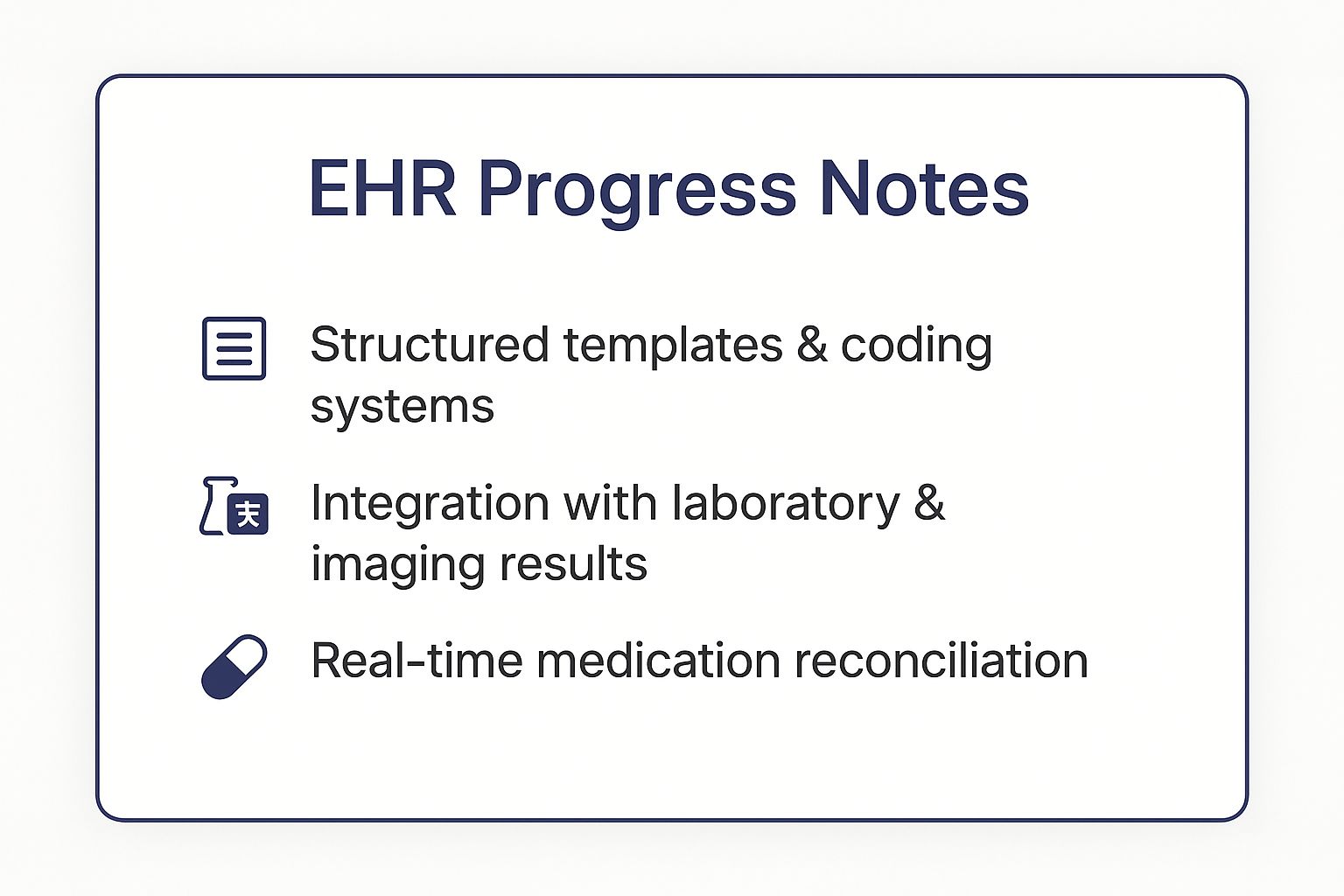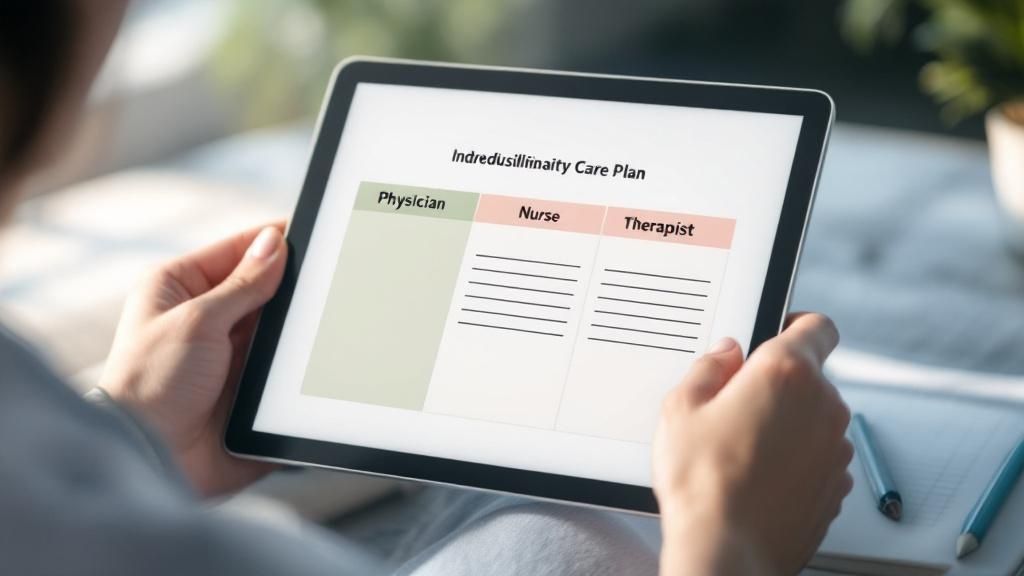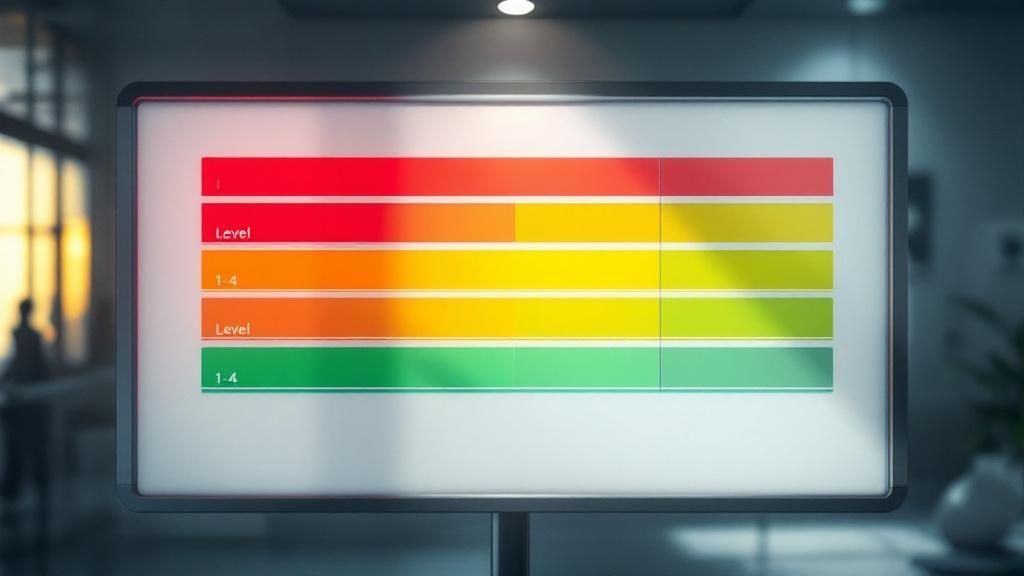Your Go-To Guide for Patient Medical Chart Examples
A well-structured patient medical chart is the backbone of effective healthcare delivery, ensuring continuity of care, accurate billing, and legal compliance. However, knowing what a truly effective chart looks like can be challenging. This guide moves beyond theory to provide a practical, in-depth analysis of various patient medical chart examples. We will break down each type, from standard SOAP notes to complex interdisciplinary care plans, to show you precisely what works and why.
Instead of just presenting templates, we will dissect each patient medical chart example to uncover the strategic thinking behind its design. You will gain actionable insights and specific tactics for improving your own documentation processes. We will explore key elements like data flow, clinician usability, and how specific layouts support different clinical scenarios.
By the end of this article, you will have a clear understanding of best practices for various charting situations, including:
- Electronic Health Record (EHR) Progress Notes
- SOAP Note Format Medical Charts
- Interdisciplinary Care Plan Charts
- Emergency Department Triage Charts
- Chronic Disease Management Charts
- Surgical Operative Report Charts
- Mental Health Assessment Charts
This resource is designed for everyone from practice managers to frontline clinicians seeking to enhance clarity, efficiency, and patient safety through superior charting. Let's dive into the examples.
1. Electronic Health Record (EHR) Progress Notes
Electronic Health Record (EHR) progress notes represent the digital evolution of traditional patient charting. They are comprehensive, real-time records of a patient's clinical status and care plan, created during or after an encounter. Unlike static paper files, EHR notes are dynamic documents within an interconnected system. This system allows for structured data entry using standardized templates, ensuring every note captures critical information like the chief complaint, history of present illness (HPI), physical exam findings, assessment, and plan (SOAP format).
The power of EHR progress notes lies in their interoperability. Leading healthcare systems like Kaiser Permanente and Mayo Clinic leverage sophisticated EHR platforms to manage millions of patient records. These systems integrate notes with lab results, imaging reports, and pharmacy data, providing a holistic view of the patient's health. This makes the EHR progress note a prime patient medical chart example because it serves as the central narrative of a patient's journey, accessible to authorized providers across different specialties and locations.
Strategic Analysis
The strategic advantage of using EHR progress notes is profound. It moves documentation from a simple record-keeping task to a powerful clinical and operational tool. By using structured data and standardized coding (like ICD-10 and CPT), healthcare organizations can analyze patient populations, track outcomes, and ensure accurate billing. For example, a clinic can quickly identify all diabetic patients with an A1c above a certain level, allowing for targeted outreach and better disease management. This data-driven approach is simply not feasible with paper charts. Furthermore, features like clinical decision support can be embedded directly into the note-taking process, alerting providers to potential drug interactions or reminding them of necessary health screenings.
Key Features of Effective EHR Progress Notes
To maximize their utility, EHR progress notes rely on several core components. This infographic highlights three essential features that transform a simple note into a robust clinical instrument.

As the graphic illustrates, the combination of structured templates, data integration, and real-time medication management creates a comprehensive and safe charting environment. This structure ensures that every patient's story is told consistently and accurately, which is fundamental to quality care.
Actionable Takeaways
To effectively implement and utilize EHR progress notes, consider these best practices:
- Standardize Templates: Develop or adopt standardized templates for common visit types (e.g., new patient, follow-up, annual wellness). This ensures consistency and saves time.
- Use Copy-Forward with Caution: While a time-saver, the copy-forward feature can perpetuate outdated or incorrect information. Always review and edit copied text to reflect the current encounter accurately.
- Maintain Problem and Medication Lists: Regularly update the patient’s active problem list and medication record during each visit. This is crucial for clinical decision-making and patient safety.
- Be Specific and Thorough: Include relevant negative findings to show a comprehensive examination. Use standardized medical abbreviations to maintain clarity and avoid misinterpretation.
2. SOAP Note Format Medical Chart
The SOAP note format is a universally recognized method for documenting patient encounters, providing a clear and logical framework for clinical reasoning. Developed by Dr. Lawrence Weed, it organizes information into four distinct sections: Subjective, Objective, Assessment, and Plan. This structure guides the healthcare provider through the process of gathering patient-reported information (Subjective), recording measurable clinical data (Objective), forming a diagnosis or clinical impression (Assessment), and outlining the next steps for treatment (Plan). The SOAP note is a cornerstone of medical documentation, used across virtually all specialties and settings.
This systematic approach is why the SOAP note is a quintessential patient medical chart example. Its simple yet powerful structure ensures that all critical components of a patient visit are captured and communicated effectively. Elite institutions like Johns Hopkins Hospital and Cleveland Clinic rely on this format for everything from emergency department triage to primary care follow-ups. The clarity and organization it provides are vital for continuity of care, allowing any provider to quickly understand a patient's status and the rationale behind their current treatment plan.

Strategic Analysis
Strategically, the SOAP note format moves documentation from a simple narrative into a problem-oriented analytical tool. By separating subjective complaints from objective findings, it forces a clinician to build a logical case for their assessment and subsequent plan. This structured thinking is crucial for accurate diagnosis and effective treatment. Furthermore, its standardized format facilitates efficient communication among interdisciplinary teams, which is critical in complex care environments like an ICU or a busy specialty clinic. For a healthcare organization, mandating this format enhances quality control and simplifies chart reviews and audits.
The analytical power of the SOAP format also extends to education and training. It serves as a foundational teaching tool for medical students and residents, helping them develop and demonstrate their clinical reasoning skills. For telemedicine providers, a well-structured SOAP note ensures that virtual consultations are documented with the same rigor as in-person visits, supporting both quality care and proper billing. You can dive deeper into its applications and download a free SOAP note template to see its structure in action.
Actionable Takeaways
To maximize the effectiveness of the SOAP note format in your practice, consider these specific actions:
- Quote the Patient: In the Subjective section, use direct quotes or the patient's own words whenever possible (e.g., "I have a crushing pain in my chest"). This preserves the patient's unique perspective.
- Be Specific in the Plan: The Plan should be detailed and actionable. Instead of just writing "Follow-up," specify the timeline and purpose, such as "Follow-up in 2 weeks to reassess blood pressure and review lab results."
- Include Differential Diagnoses: In the Assessment section, especially for new or complex problems, list potential differential diagnoses. This demonstrates a thorough thought process and guides future diagnostic steps.
- Separate Problems: If a patient presents with multiple issues, create a separate SOAP structure for each one. This keeps the documentation organized and ensures each problem is fully addressed.
3. Interdisciplinary Care Plan Chart
An Interdisciplinary Care Plan (ICP) Chart is a collaborative documentation tool that integrates input from multiple healthcare disciplines, such as physicians, nurses, therapists, and social workers. This type of chart shifts the focus from siloed, discipline-specific notes to a unified, patient-centered plan. It tracks progress toward shared goals, ensuring that every member of the care team is aligned and working cohesively. The ICP format is essential in complex care environments where a patient's needs span multiple specialties.

This model is a cornerstone for organizations like cancer treatment centers using multidisciplinary tumor boards and rehabilitation hospitals with team-based care models. For instance, in a long-term care facility, the ICP coordinates services from nursing, physical therapy, nutrition, and social work to manage a resident's overall well-being. This integrated approach makes the ICP a powerful patient medical chart example because it documents not just individual actions, but the collective strategy of the entire care team.
Strategic Analysis
The strategic advantage of an Interdisciplinary Care Plan Chart is its ability to break down communication barriers and improve care coordination. This moves charting beyond a record of individual tasks to a dynamic, strategic tool for collaborative patient management. By centralizing goals and interventions, organizations can reduce redundant testing, prevent conflicting treatments, and ensure a seamless patient experience. This is especially critical in managing complex chronic conditions or during transitions of care, such as from hospital to home.
Organizations like the Institute for Healthcare Improvement and The Joint Commission champion this approach because it directly correlates with improved patient outcomes and safety. A well-executed ICP can lead to shorter hospital stays, lower readmission rates, and higher patient satisfaction. It provides a clear, comprehensive overview that allows any team member to understand the complete care picture at a glance, fostering accountability and shared responsibility for patient progress.
Key Features of Effective Interdisciplinary Care Plans
To be truly effective, an ICP must be more than just a shared document. It needs specific features that facilitate genuine collaboration and goal-oriented care.
As the image highlights, this chart format typically centralizes patient-centered goals, assigns specific interventions to each discipline, and includes a timeline for tracking progress. This structure ensures that every team member understands their role in the larger care strategy and can see how their contributions impact overall patient outcomes. The emphasis is on a unified narrative rather than fragmented notes.
Actionable Takeaways
To successfully implement an Interdisciplinary Care Plan Chart, focus on fostering a collaborative culture and standardizing the process:
- Establish Clear Roles: Define and document the responsibilities of each discipline within the care plan. This prevents overlap and ensures all aspects of care are covered.
- Schedule Regular Team Meetings: Hold brief, regular huddles or formal meetings to discuss patient progress, review goals, and adjust the plan as a team.
- Use Shared Terminology: Develop a common language and standardized goal formats (e.g., SMART goals) that are understood by all team members, from physicians to therapists.
- Incorporate Patient & Family Input: The patient's own goals are paramount. Actively involve patients and their families in the care planning process to ensure the plan reflects their priorities.
- Maintain Real-Time Updates: Ensure that all team members update the plan promptly after their interventions. A plan based on outdated information is ineffective and potentially unsafe.
4. Emergency Department Triage Chart
An Emergency Department (ED) Triage Chart is a highly specialized tool designed for the rapid assessment and prioritization of patients in high-pressure emergency settings. This chart is structured to guide clinicians through a standardized protocol, enabling them to quickly determine a patient's acuity level and the urgency of their need for care. It relies on validated scoring systems to categorize patients, ensuring that the most critically ill individuals receive immediate attention while efficiently managing patient flow and resource allocation.

The triage chart is an exceptional patient medical chart example because it highlights documentation under extreme time constraints. Renowned institutions like Mass General Brigham utilize the Emergency Severity Index (ESI), while Canadian hospitals such as Toronto General Hospital implement the Canadian Triage and Acuity Scale (CTAS). These systems standardize the initial encounter, capturing vital signs, chief complaint, and key assessment findings in a format that is concise yet comprehensive. The structure of these charts is critical for clear communication from the triage nurse to the rest of the ED team, setting the stage for the entire patient visit.
Strategic Analysis
The strategic value of a standardized ED Triage Chart is rooted in risk management and operational efficiency. By implementing a validated system like ESI or CTAS, a hospital systematically reduces the risk of delayed care for high-acuity patients, which directly impacts clinical outcomes and potential liability. This structured approach moves triage from a subjective judgment to an evidence-based process. Operationally, these charts provide real-time data on patient volume, acuity levels, and wait times. This data allows department managers to dynamically allocate nursing staff, open or close treatment areas, and anticipate resource needs, optimizing patient throughput and minimizing dangerous overcrowding.
Key Features of Effective ED Triage Charts
To be effective, an ED Triage Chart must facilitate swift, accurate, and defensible clinical decisions. It serves not just as a record but as a critical communication and safety instrument. This infographic breaks down the essential components that make a triage chart a cornerstone of emergency medicine.

As the graphic shows, the combination of a validated acuity scale, precise time-stamping, and designated fields for reassessment creates a robust framework. This ensures that every patient is triaged using a consistent methodology and that those waiting for care are continuously monitored for any change in their condition.
Actionable Takeaways
To effectively use ED Triage Charts and improve patient safety, emergency departments should focus on these best practices:
- Consistent Protocol Use: Ensure all triage staff are thoroughly trained and consistently apply a single, standardized protocol like ESI or CTAS. Regular audits and competency checks are essential.
- Document Reassessment Times: For patients in the waiting room, it is crucial to document periodic reassessments. This creates a legal record of ongoing monitoring and helps catch any deterioration in a patient's condition.
- Include Clear Disposition and Timestamps: Every entry on the chart must be time-stamped, from arrival to final disposition (e.g., admitted, discharged, transferred). This clarity is vital for both clinical handoffs and administrative review.
- Maintain Objectivity: Triage assessments should be based on objective data like vital signs and specific clinical indicators defined by the protocol, rather than subjective impressions. This ensures fairness and accuracy in prioritization.
5. Chronic Disease Management Chart
A Chronic Disease Management Chart is a specialized documentation system designed to track long-term health conditions. This chart format emphasizes continuity of care, monitoring disease progression, and managing ongoing treatment plans for conditions such as diabetes, hypertension, and heart disease. Unlike acute care notes that focus on a single episode, these charts provide a longitudinal view of a patient's health, integrating data over months and years to reveal trends and inform long-term strategies.
The core function of this chart is to centralize all relevant information for a specific chronic condition. Leading institutions like the Joslin Diabetes Center and Cleveland Clinic have pioneered these models to manage complex patient populations effectively. By using a dedicated format, they ensure that key metrics, patient goals, and specialist communications are consistently captured. This makes the Chronic Disease Management Chart a powerful patient medical chart example because it transforms documentation from a reactive record into a proactive tool for preventing complications and improving quality of life.
Strategic Analysis
The strategic advantage of a dedicated Chronic Disease Management Chart lies in its ability to support value-based care models. It shifts the focus from fee-for-service encounters to long-term outcome management. By tracking standardized, disease-specific metrics (e.g., HbA1c for diabetes, blood pressure readings for hypertension), organizations can demonstrate improved patient outcomes, a key requirement for reimbursement under many modern payment structures. For example, a practice can systematically track medication adherence and patient-reported outcomes, allowing for timely interventions before a patient's condition deteriorates and requires costly hospitalization. This structured approach also facilitates seamless care coordination between primary care providers and specialists, ensuring everyone is working from the same comprehensive information.
Key Features of Effective Chronic Disease Charts
To be effective, these charts must move beyond simple data entry and become a hub for collaborative care. They need to integrate multiple data streams and patient-centric information to provide a holistic view of the chronic condition.
- Standardized Metrics: Tracking includes key clinical data points specific to the disease, such as lab results (HbA1c, cholesterol), vital signs (blood pressure, weight), and procedure outcomes. This allows for consistent monitoring of disease control.
- Patient-Reported Outcomes (PROs): Capturing the patient's perspective is crucial. This includes symptom severity, quality of life surveys, and self-management challenges. PROs provide insights that clinical data alone cannot.
- Medication & Adherence Tracking: The chart details all medications, dosages, and changes over time. It also includes notes on patient adherence and any reported side effects, which is vital for optimizing treatment.
- Education & Goal Setting: This component documents patient education provided, their understanding, and mutually agreed-upon health goals. This empowers patients to take an active role in their care. The plan established here often informs the instructions given upon leaving a care facility, which is a key part of effective documentation, as you can explore in this sample discharge summary.
Actionable Takeaways
To implement a successful chronic disease management charting system, healthcare providers should focus on structure and patient engagement:
- Develop Disease-Specific Templates: Create or adopt standardized flowsheets or templates for each major chronic condition your practice manages. This ensures all critical data is captured at every visit.
- Integrate Patient-Reported Data: Use patient portals or in-office tablets to collect PROs before the appointment. This saves clinical time and provides valuable information for the visit.
- Set Up Alerts for Key Metrics: Configure your EHR to flag when a patient's key metrics fall outside the target range. This enables proactive outreach and timely intervention.
- Schedule Regular Chart Reviews: Dedicate time for care teams to review charts for high-risk patients. This helps identify trends and coordinate care plans between primary care and specialty providers.
6. Surgical Operative Report Chart
A Surgical Operative Report is a highly detailed, formal record that chronicles every aspect of a surgical procedure. This critical document provides a comprehensive narrative, from the final pre-operative diagnosis to the patient's condition upon leaving the operating room. It outlines the surgical team, anesthesia used, specific techniques employed, findings during the operation, and the immediate post-operative plan. Unlike a progress note, this report is a standalone, in-depth account of a single, significant clinical event.
The operative report serves as a vital medical, legal, and billing document. Esteemed institutions like the Mayo Clinic and Johns Hopkins have refined their surgical documentation to meet the rigorous standards set by bodies such as the American College of Surgeons and The Joint Commission. This type of chart is an essential patient medical chart example because it demonstrates the pinnacle of procedural documentation, capturing a high-stakes intervention with precision and clarity for continuity of care.
Strategic Analysis
Strategically, the operative report is indispensable for risk management and quality assurance. It provides a definitive legal record of the care provided, which is crucial in the event of an adverse outcome or medical review. For healthcare organizations, standardizing these reports allows for the aggregation and analysis of surgical data. For instance, an orthopedic department at a facility like the Hospital for Special Surgery could analyze operative times, implant usage, and complication rates across thousands of joint replacement reports to identify best practices and areas for process improvement. This level of analysis supports clinical research, improves patient safety, and optimizes resource allocation within the surgical department.
Key Features of an Effective Surgical Operative Report
A robust operative report must be comprehensive and unambiguous. The structure is designed to leave no room for interpretation, ensuring any provider can understand exactly what occurred during the procedure. Here are the core components:
- Pre-operative and Post-operative Diagnosis: Clearly states the reason for the surgery and the diagnosis after its completion.
- Procedure Performed: A concise, standardized name for the surgical intervention.
- Detailed Narrative: This section describes the patient's positioning, the surgical approach, a step-by-step account of the procedure, anatomical findings, and the closing technique.
- Specimens and Drains: Documents any tissues sent to pathology or drains left in place.
- Complications and Blood Loss: Records the estimated blood loss and details any unexpected events or complications and how they were managed.
This structured format ensures all critical information is captured, supporting patient safety and seamless post-operative care transitions.
Actionable Takeaways
To ensure your surgical operative reports are effective and compliant, adhere to these best practices:
- Document Immediately: Complete and sign the operative report as soon as possible after the procedure. This ensures accuracy while details are fresh and meets regulatory requirements for timely documentation.
- Use Standardized Terminology: Employ accepted medical and anatomical terms to ensure clarity and avoid ambiguity. This is critical for communication with other healthcare professionals.
- Be Meticulously Detailed: Describe the procedure step-by-step. Include key findings, both normal and abnormal, and specify the types of sutures, implants, or devices used.
- Record All Complications: Document any intraoperative complication, no matter how minor, and describe the exact steps taken to manage it. This transparency is vital for legal protection and quality improvement.
7. Mental Health Assessment Chart
A Mental Health Assessment Chart is a specialized documentation format designed for psychiatric and psychological evaluations. It goes beyond a standard medical history to capture the nuances of a patient's mental state, emotional well-being, and cognitive function. This type of chart incorporates specific tools like the Mental Status Examination (MSE), risk assessments for self-harm or harm to others, and detailed tracking against diagnostic criteria from frameworks like the DSM-5. Its structure is tailored to document the therapeutic process and patient progress over time.
Leading behavioral health services, such as those in inpatient psychiatry units at major hospitals or community mental health centers, rely on these detailed charts. They are essential for creating a comprehensive picture that includes not just symptoms but also social history, trauma history, substance use, and protective factors. This specialized format makes the Mental Health Assessment Chart a crucial patient medical chart example because it highlights how documentation must be adapted for different clinical disciplines to ensure safe and effective care.
Strategic Analysis
The strategic value of a dedicated Mental Health Assessment Chart is its focus on risk management and treatment efficacy. By standardizing the documentation of suicidality, homicidality, and grave disability, it provides a clear, legal record of assessment and intervention, which is critical in this high-stakes field. It also facilitates a more holistic and person-centered approach to care. Documenting direct patient quotes, behavioral observations, and progress toward therapeutic goals helps clinicians build stronger therapeutic alliances and tailor treatment plans more effectively. This structured yet nuanced approach supports both evidence-based care and compliance with stringent state and federal regulations governing mental health records.
Key Features of Effective Mental Health Charts
To be effective, a mental health chart must balance structured data with narrative detail. It must provide a framework for consistent evaluation while allowing space for the individual patient's story. Key components include:
- Mental Status Examination (MSE): A systematic appraisal of the patient's appearance, behavior, mood, affect, speech, thought process, thought content, perception, cognition, and insight.
- Comprehensive Risk Assessment: Detailed documentation of risk factors (e.g., past attempts, access to means) and protective factors (e.g., family support, reasons for living).
- Diagnostic Formulation: A narrative summary that synthesizes the patient's history, symptoms, and MSE findings to support a differential diagnosis based on established criteria.
This combination ensures that evaluations are thorough, replicable, and centered on the most critical aspect of mental healthcare: patient safety.
Actionable Takeaways
To implement and maintain high-quality mental health documentation, consider these best practices:
- Use Person-First Language: Always refer to "a person with schizophrenia" rather than "a schizophrenic." This language emphasizes the individual over the diagnosis and promotes a respectful, therapeutic tone.
- Document Risk Factors and Protective Factors: A balanced risk assessment is crucial. Clearly list factors that increase risk alongside those that mitigate it to create a complete clinical picture for safety planning.
- Include Direct Quotes When Relevant: Quoting the patient directly can provide powerful insight into their thought processes, beliefs, and emotional state, adding valuable context that paraphrasing might lose.
- Maintain a Therapeutic Tone: Notes should be objective and professional but also reflect a therapeutic, non-judgmental stance. This is important as patients often have the right to access their own records.
7 Key Patient Chart Types Compared
| Documentation Type | Implementation Complexity 🔄 | Resource Requirements ⚡ | Expected Outcomes 📊 | Ideal Use Cases 💡 | Key Advantages ⭐ |
|---|---|---|---|---|---|
| Electronic Health Record (EHR) Progress Notes | High due to system integration, training | High: IT infrastructure & maintenance | Improved coordination, real-time access, error reduction | Large healthcare systems needing standardized, interoperable records | Enhanced legibility, clinical alerts, automated billing |
| SOAP Note Format Medical Chart | Moderate; requires training but adaptable | Low to moderate; paper or electronic | Comprehensive, systematic documentation | All healthcare settings, especially education and quality assurance | Universally recognized, promotes systematic thinking |
| Interdisciplinary Care Plan Chart | High; significant coordination and collaboration | High: multi-disciplinary involvement | Improved outcomes via coordinated care | Acute, rehab, long-term care needing team-based approaches | Reduces communication gaps, supports value-based care |
| Emergency Department Triage Chart | Moderate to high; needs specialized training | Moderate; emphasis on speed and accuracy | Rapid assessment, optimized patient flow | Emergency departments prioritizing acuity and resource allocation | Standardized triage, reduces wait times |
| Chronic Disease Management Chart | Moderate; ongoing updates needed | Moderate; requires multiple provider input | Better long-term outcomes, preventive care | Chronic illness management programs | Supports trend analysis, patient engagement |
| Surgical Operative Report Chart | High; time-sensitive, specialized medical language | Moderate to high; immediate post-op updates | Complete surgical documentation, legal protection | Surgical departments requiring detailed procedure records | Supports QA, billing accuracy, continuity of care |
| Mental Health Assessment Chart | High; requires psychiatric expertise | Moderate; secure handling of sensitive data | Comprehensive mental health assessment, safety | Psychiatry, psychology, behavioral health clinics | Risk management, evidence-based planning, therapeutic rapport |
Charting a Course for Clinical Excellence
Navigating the landscape of patient documentation can feel complex, but as we've explored through each patient medical chart example, the core principles remain constant: clarity, accuracy, and efficiency. From the structured logic of the SOAP note to the comprehensive detail of a surgical operative report, these documents are far more than administrative tasks. They are the narrative of patient care, the foundation of clinical decision-making, and the primary tool for ensuring continuity and safety.
We've broken down diverse formats, including EHR progress notes, interdisciplinary care plans, and specialized charts for emergency, chronic, and mental health care. Each example illustrates a unique approach tailored to a specific clinical context, yet they all share a common goal. They aim to capture a complete and actionable picture of a patient's health, facilitating seamless communication among providers and leading to better outcomes.
Your Strategic Takeaways and Next Steps
The true value of studying any patient medical chart example lies in applying the underlying strategies to your own practice. The goal is not to perfectly replicate a template but to internalize the principles of effective documentation. Here are the most critical takeaways to implement immediately:
- Standardize for Consistency: As seen in the Emergency Department Triage Chart, standardization is key. Establish clear, consistent charting protocols across your practice to reduce ambiguity and minimize errors. This ensures every team member speaks the same clinical language.
- Prioritize Problem-Oriented Structure: The SOAP note format is powerful because it is logical and problem-focused. Apply this thinking to all your notes. Clearly identify the patient's problem, your objective findings, your assessment, and a concrete plan. This structure makes information easy to find and act upon.
- Embrace Collaborative Documentation: The Interdisciplinary Care Plan Chart highlights that modern healthcare is a team sport. Your charting should reflect this. Create workflows that make it easy for specialists, nurses, and other allied health professionals to contribute to a single, unified patient record.
By focusing on these core principles, you transform charting from a burdensome requirement into a strategic asset. Well-crafted medical charts reduce clinical risk, improve billing accuracy, and most importantly, support the delivery of exceptional patient care. Mastering this skill is a direct investment in your practice's operational health and your patients' well-being. It’s about building a system of record that is as robust and reliable as the care you strive to provide every single day.
Ready to elevate your clinical documentation with intelligent automation? Simbie AI leverages advanced technology to streamline charting, reduce administrative burnout, and ensure your patient records are consistently clear and comprehensive. Discover how you can save time and improve accuracy by visiting Simbie AI today.

